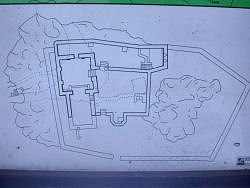Volkmarskeller
Useful Information
| Location: |
B6 exit Blankenburg Nord, turn right to Oesig and Michaelstein.
Kloster Michaelstein is signposter.
From Michaelstein up the valley for 3.5 km.
Alternatively from Jasperode/Eggeröder Brunnen down the valley for 1.5 km. |
| Open: |
no restrictions. [2008] |
| Fee: |
free. [2008] |
| Classification: |
 Karst Cave Karst Cave
|
| Light: | bring torch |
| Dimension: | |
| Guided tours: | |
| Photography: | |
| Accessibility: | |
| Bibliography: | |
| Address: | |
| As far as we know this information was accurate when it was published (see years in brackets), but may have changed since then. Please check rates and details directly with the companies in question if you need more recent info. |
|
History
| 956 | first written mention of St. Michaels Church above the cave. |
| 1118 | death of the hermit Bernhardus who lived in the cave. |
| 1146 | monastery Michaelstein errected above the cave. |
| 1167 | monastery relocated to the entrance of the valley. |
| 1277 | written mention of a Volkmann-Kapelle (Volkmann Chapel). |
| 1313 | written mention of a Marien- und Volkmann-Kapelle (Mary and Volkmann Chapel). |
| 1467 | last mention of the chapel. |
| 1884-87 | excavated by Baurat Brinkmann. |
| 1927 | survey by Stolberg. |
| 1933 | description by Biese. |
| 1973 | new passage discovered by Tschorn and Förster. |
| MAR-2006 | visited by Franz Lindenmayr. |
Description

The Volkmarskeller is a small cave located at the northern rim of the Harz. From the Kloster Michaelstein, which is located at the northwestern outskirts of Blankenburg, it is reached on a 3.5 km long hike up the valley. An alternative way to the cave is from the forester’s house Eggeröder Brunnen which belongs to the village Jasperode. From here the trail goes down the valley along the brook which springs at Eggeröder Brunnen. This walk is only about one and a half kilometers and there is another highlight on the way: after about one kilometre the opening of an old adit surrounded by pillow lava can be seen, the water flowing out is draining a historic iron mine. The cave is very well signposted and easy to find.

According to legend an anchoress (Incluse) lived in the cave named Luitbirg, the time given differs, some say around 850, others around 950. Others tell a hermit named Volkmar lived in the cave which would explain the name. Volkmar had followers, the Volkmarsbrüder (Volkmar’s Brothers) who later merged with the cisterciense monks. Actually both is unlikely, as Liutbirg lived in a hermitage between 850 and 870, but Walther Grosse, a German historian, discovered in the 1930s that this place was Kloster Wendhusen near Thale. And the name of cave has nothing to do with a man named Volkmar, who most likely did not exit. However, the cave was used by hermits, a document from 1118 tells about the death of Bernhardus presbyter solitarius de Laide sancti Michaelis.

We can understand that this cave is quite comfortable as it has some size, a chimney, and a spring with fresh water right below. But the legend also tells the cave was converted into a christian church. There was an altar, crosses at the wall and a passage from the cave to the monastery above, which is now gated. It is impossible to know how much of this legend is based on reality and how much is just a story. There was a chapel on top of the cave and so a cave church was not necessary.
The first written mention of this cave is from 956, which mentions a chapel dedicated to St. Michael above cave, which was bestowed by Otto I. to the Stift Quedlinburg. This chapel was extended for the foundation of the cisterciense monastery in 1146, but only 20 years later the monastery was relocated to the lower end of the valley. But a church remained on the rock, mentioned as Volkmann-Kapelle in 1277, then Marien- und Volkmann-Kapelle in 1313, and finally the last mention in 1467. The cave name is most likely an alteration of Volkmann. It seems the church had a connection with the iron mining and smelting activities in this area between the 9th and 12th century. Today the chapel is destroyed completely, only some foundation walls can be seen. But the name Volkmann seems to have survived in the name of the cave.
The cave was first explored during the 19th century. At this time the cave was filled with debris almost to the ceiling. Baurat (the head of the planning and building department) Brinkmann excavated the cave and discovered remains of the church and skeletons of three adults and three children in front of the altar. The story behind this burial is unknown.
After the cave was excavated again, it became popular with the organized cavers of the Harz. It was dry, big enough, and the spring could be used to cool beer (caver pragmatism...). There is a fireplace in the middle of the cave, which is obviously still used, although fire in caves is nowadays strictly forbidden by environmental laws. After World War II the local cavers used the cave for Christmas parties and other parties.

|
| Volkmarskeller Gallery |
 Search DuckDuckGo for "Volkmarskeller"
Search DuckDuckGo for "Volkmarskeller" Google Earth Placemark
Google Earth Placemark Volkmarskeller - Wikipedia
Volkmarskeller - Wikipedia
 Index
Index Topics
Topics Hierarchical
Hierarchical Countries
Countries Maps
Maps